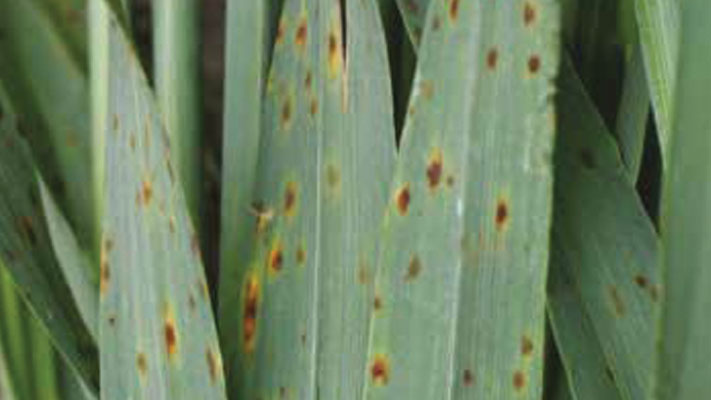Net form net blotch
Net form net blotch (NFNB) is a common disease affecting barley and barley grass in Australia. Two kinds of net blotch occur, net form and spot form. Early sowing increases the risk of infection by NFNB. Yield losses of 10 - 30 per cent as well as reductions in grain quality, particularly increased screenings, can occur if not managed properly.
Refer to the link below for more detailed information on spot form net blotch in barley.

Description
Lesions begin as thin brown streaks which elongate up and across the leaf, and darker lines form within the lesions, producing a net like appearance. Lesions are often surrounded by a yellow leaf margin. In severe infections leaves die prematurely causing reductions in seed weight and yields.
NFNB can be stubble or seed-borne although generally, infected stubbles are the main cause of primary infection and more occasionally, barley grass residues. Spores can survive on infected stubble for up to three years. Early season rains release spores from infected stubbles, which are spread by wind onto barley seedlings. For infection to be successful, moisture and temperatures between 10 °C and 25 °C are required. Following primary infection, lesions produce spores which can be released producing inoculum for secondary infections. This process can occur several times throughout the growing season. Seed infections can occur when humid conditions follow flowering, although seed infections are rare and not considered to be of importance compared to infected stubbles.
Control
NFNB can be controlled effectively by employing a range of tactics. Avoid growing successive barley crops, particularly in areas prone to NFNB, hence a three-year gap between barley crops is suggested. In high risk areas avoid sowing susceptible varieties, instead select varieties with resistance. Removal of infected stubbles by burning, where wind erosion risks are low, and control of ‘green bridge’ volunteers can also help reduce disease levels.
References
Herbiguide (Viewed Nov 2019), ‘Net blotch – Net form of barley’, http://www.herbiguide.com.au/Descriptions/hg_Net_Blotch_Net_Form_of_Barley.htm
Jayasena, K, Thomas, G, Beard, C and Hills A (2018), ‘Managing net-type net blotch of barley in Western Australia’, Department of Primary Industrie and Regional Development (DPIRD), https://www.agric.wa.gov.au/barley/managing-net-type-net-blotch-barley-western-australia
McClean, M (2016), ‘Net blotches of barley’, Agriculture Victoria, http://agriculture.vic.gov.au/agriculture/pests-diseases-and-weeds/plant-diseases/grains-pulses-and-cereals/net-blotches-of-barley





